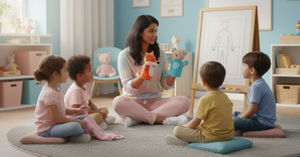“When little people are overwhelmed by big emotions, it’s our job to share our calm, not join their chaos.” – L.R. Knost
Every parent has faced the moment: a loud, public tantrum with flailing arms, tears, or stubborn silence. Tantrums, while common, can leave caregivers exhausted and confused. But beneath the surface of this storm lies something deeper, a developing brain trying to make sense of overwhelming emotions.
What if the answer to fewer tantrums and better behavior didn’t lie in time-outs or stricter rules alone, but in something softer, kindness and empathy?
Research now shows that children who are taught to understand and care about others’ feelings from an early age are better at managing their own. Simply put, when kids are equipped with the emotional tools to recognize how someone else feels, they learn to do the same with their own emotions, and that’s where tantrum control begins.
Tantrums: What’s Really Going On?
Tantrums are a natural part of early childhood. They typically peak between the ages 2 to 4, when language is still developing and emotional regulation is limited. Children at this age experience frustration, fatigue, and disappointment just like adults, but they lack the tools to express it.
From a neurological standpoint, the amygdala (the brain’s emotional center) is highly active in toddlers, while the prefrontal cortex (which helps control impulses and think rationally) is still maturing. This mismatch explains why meltdowns happen so easily and why logic often fails in the heat of the moment.
But here’s the important part: when children are taught empathy, they begin to:
- Recognize that others have feelings like theirs
- Learn to pause before reacting
- Use words instead of actions to express frustration
These skills build the foundation for emotional self-awareness and impulse control.
Why Kindness is a Gateway to Better Behavior
Kindness is not just a moral lesson; it’s a behavioral tool. When children learn to notice how their actions affect others, they begin to adjust their behavior. This shift doesn’t happen through punishment; it happens through emotional development.
Here’s how empathy helps reduce behavioral outbursts:
1. It builds emotional vocabulary
Children who are taught about feelings, both their own and others’, develop the words to express what they’re going through. A child who can say, “I’m mad because I didn’t get a turn,” is less likely to throw a toy across the room.
2. It reduces emotional overload
Empathy helps children recognize that their emotions are valid but manageable. This reduces the intensity of emotional responses over time.
3. It teaches cause and effect
When a child learns that hitting makes someone else cry, and that this causes disconnection or time away, they slowly develop internal cues to avoid those actions.
4. It creates connections
Children who feel understood are more likely to cooperate. When empathy is modeled by parents, children feel safe, and tantrums lose their power.
Teaching Empathy: The Earlier, the Better
Early childhood is a sensitive period for developing empathy. Brain circuits involved in emotional understanding are most flexible in the first five years of life. This is when parents, caregivers, and teachers have the most influence.
Unlike academic skills, empathy is learned through relationships, not instruction. Daily experiences — not lessons or punishments are what shape the child’s inner emotional world.
Here are simple strategies to raise empathetic, emotionally balanced children:
Describe feelings in real time
When your child is upset, name the emotion gently: “You look really frustrated because the block tower fell.” This builds recognition.
Mirror their emotions, not their behaviour
Stay calm during tantrums. Say, “I see you’re very angry. It’s okay to feel that way, and I’m here.” Avoid reacting with equal intensity.
Praise emotional insight.
When your child comforts a friend or waits patiently, point it out: “That was kind of you to check on him. You noticed he was sad.”
Use books and stories.
Reading stories with rich emotional themes helps children understand different perspectives. Ask, “How do you think the bunny felt when he lost his toy?”
Model empathy every day.
Your child learns most from watching you. Show patience with others. Apologize when you’re wrong. Express gratitude often.
When Kindness Helps Diffuse Tantrums
Let’s walk through an example.
Imagine your three-year-old throws a tantrum after losing a game. You respond calmly:
“I can see you’re upset. It’s hard to lose sometimes. But we can try again or cheer for someone else. How do you think your friend feels when you yell?”
At first, this may seem ineffective. But over time, this consistent modeling teaches three things:
- Their emotions are understood.
- They can manage disappointment.
- Other people have feelings too.
These lessons, repeated across small moments, create a more self-aware and thoughtful child.
The Role of the Brain: From Reaction to Reflection
Neuroplasticity, the brain’s ability to change based on experiences, is very active in early childhood. When kindness and empathy are consistently practiced, the brain forms stronger connections between the emotional center (amygdala) and the thinking center (prefrontal cortex).
This means the child slowly learns to:
- Pause before reacting
- Consider consequences
- Use words, not outbursts
In simple terms, empathy helps shift the brain from reacting to reflecting. And that is the essence of emotional growth.
Parental Tips: Building Calm from Connection
- Stay connected, even during misbehavior. Children act out more when they feel misunderstood or disconnected. Choose empathy over control.
- Create emotion-rich routines. Use mealtimes, bedtime, or car rides to talk about feelings. Ask, “What made you happy today?” or “Was anything tough?”
- Avoid over-correction. Tantrums are not always about manipulation they’re often cries for help. Focus on understanding, not just fixing.
- Celebrate kindness. Notice it when it shows up. A kind gesture from your child is a step toward greater self-control.
Final Thought: A Calm Child Grows from a Kind World
You don’t need to “fix” tantrums with punishments. What a child really needs is a calm adult, an empathetic environment, and consistent emotional guidance. By planting the seeds of kindness early, you help your child grow not just into someone who behaves well, but into someone who feels deeply, relates easily, and bounces back stronger.
In the journey of parenting, you’ll see that kindness isn’t just about others it’s one of the most effective tools for helping your child understand themselves. And in that understanding, the tantrums begin to quiet not because they’re forced to, but because the child no longer needs them.








Be the first one to comment on this story.